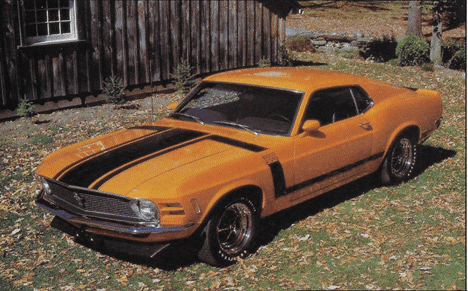Automotive history is full of many unforgettable names that have stood the test of time. While some cars have been by and large forgotten by the general public — such as the AMC Eagle, Cadillac Eldorado, the Ford Galaxie, and seemingly countless others — some remain household names like the Chevrolet Camaro, Pontiac Firebird, and, of course, the Ford Mustang.
Out of the many vehicles Ford has produced in its 120-year history, the Mustang has remained an important staple of the company since its debut in 1964. This vehicle has certainly undergone many changes through the years with evolving markets and new government regulations, but Ford has continued offering quality and performance. The manufacturer has produced numerous stunning iterations of this fine vehicle, including the 1970 Mustang Boss 302.
History of the Ford Leading up to the 1970 Mustang Boss 302
 Since the Mustang’s debut, Ford has been able to accumulate a loyal fan base through its attention to performance and price. This, of course, all began with the first-generation 1964 ½ Mustang introduced on April 17th, 1964.
Since the Mustang’s debut, Ford has been able to accumulate a loyal fan base through its attention to performance and price. This, of course, all began with the first-generation 1964 ½ Mustang introduced on April 17th, 1964.
Ford executive Lee Iacocca first began working on the Mustang in 1961. His general manager and chief engineer, Donald N. Frey, was the primary developer of the T-5 project, where he designed the 1962 Ford Mustang I concept car.
The Mustang I concept car was an important step in the right direction, but the 1964 ½ Mustang doesn’t bear much resemblance to this earlier iteration.
When the first-generation Mustang debuted, it made an immediate splash, especially because the sporty pony car essentially created a new market and didn’t have any substantial competition. The closest rival was arguably the Chevrolet Corvair, but this car paled in comparison to the Mustang’s sleek style and breathtaking performance.
Another important element of the Mustang’s debut was that this was the first sporty-looking car that Ford had released since the luxurious Ford Thunderbird, which debuted back in 1955.
The new Mustang targeted the youth market and captured the nation’s attention, and its sales reflected the public’s enthusiasm. Ford sold 121,538 units before the 1965 models became available on October 1, and the company even sold over a million units within 24 months, an impressive sales record that remains to this day.
Ford’s remarkable new vehicle was also no stranger to critical acclaim, as it was the only car to ever receive the Tiffany Award for Excellence in Design.
Of course, other manufacturers began releasing cars to compete with the Mustang’s power. In response, Ford positioned the Mustang to compete in the Trans Am Racing series. The company shipped out 100 units to the acclaimed driver and designer Carroll Shelby. Shelby designed the remarkable GT-350, which was used in numerous Sports Car Club of America competitions throughout the country.
In 1967, Shelby’s company debuted the GT-500 with an FE Series 428 cu in (7.0 L) V8 engine. This landmark engine boasted two 600 CFM Holley four-barrel carburetors on top of its mid-rise aluminum intake manifold. Shelby and Ford marketed the vehicle as having 355 horsepower, but this was a conservative estimation — some of these vehicles achieved close to 400 hp.
The Creation of the 1970 Boss Mustang 302
The Shelby Mustangs demonstrated that the vehicle could be upgraded to pack a serious performance punch. And in 1967, Ford needed to start delivering more speed to compete against the new Chevrolet Camaro. The Mustang’s 289 and 390 engines didn’t measure up to the Camaro’s small and big block V8 engines.
To compete with the Camaro, Ford began offering a Ford Boss 302 engine option for 1968 and 1969 Mustang models. Larry Shinoda styled the Boss 302 Mustang with a c-stripe, and he removed the Mustang’s fake air scoops. The Boss 302 was also one of the first production models to boast a rear deck wing and front spoiler.
The Ford Motor Company then introduced impressive changes to the 1970 Ford Boss Mustang 302 coupe such as “hockey stick” stripes, a new grille with two outside vents and dual headlights in the middle, and finned aluminum valve covers. The new Mustang came with front disc brakes, reinforced shock towers, a heavy-duty clutch, and a 3.50:21 “Daytona” rear axle.
The 1970 Ford Boss Mustang 302 engine was a high-performing 302 cu in (4.9 L) small-block OHV V8. Its power output was 290 hp at 5200 revolutions per minute, and it had a torque output of 290 foot-pounds at 4300 rpm. The car could go 0 to 60 mph in 6.9 seconds and a quarter mile within 14.6 seconds.
Get Premium Insurance For Your 1970 Boss Mustang
If you’re driving a 1970 Boss Mustang 302 or another stunning muscle car, you need protective car insurance customized to your needs. Mustang enthusiasts count on Classic Auto Insurance to preserve their powerful and stylish vehicles because we offer flexible and affordable policies as well as great benefits.
To learn more, call us today at 888-901-1338, or get an instant quote online here.





